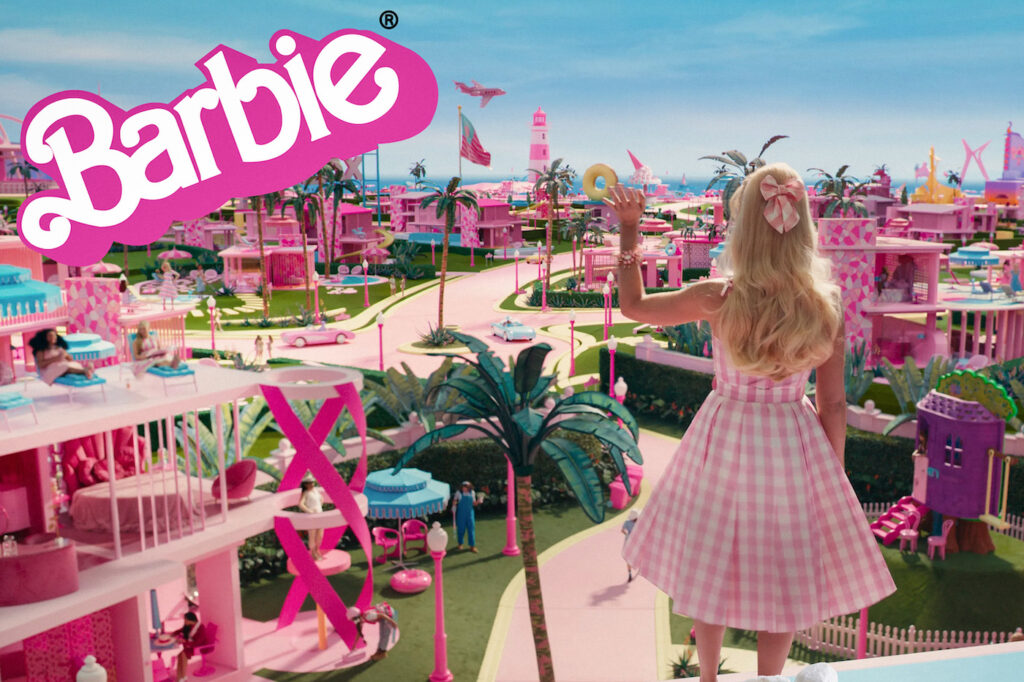Not often does a movie earn fascination from the entire country and leave viewers with such conflicting interpretations. But Greta Gerwig’s Barbie has done exactly this: some see the movie as a celebration of millennial motherhood, while others see it as an outlet for female angst, and still others think it’s an anti-man rallying cry. Yet even amid these wildly conflicting interpretations, what’s clear is that the movie is far more than a kitschy story about a plastic doll.
Notably absent from the discussion is the movie’s quiet critique of transhumanism. Barbieland, a realm that parallels the human world, is a society of deified womanhood. Barbies are an immaculate race of women who run everything, from the Supreme Court to the construction industry. Every night is girls’ night. Kens are superfluous ornaments to the Barbies’ dazzling brilliance.
But in Barbieland, no one has children or parents, wrinkles or cellulite, food or drink, or even genitals. Barbieland is the logical outcome of a feminism that aspires to empower women—in their beauty, talents, professions, relationships, and sexuality—beyond their natural human limits. Barbie isn’t anti-feminist; rather, it gestures toward a more humane feminism, one that encourages women to embrace rather than erase aging, mortality, and mothering.
The Dawn of Woman
Start your day with Public Discourse
Sign up and get our daily essays sent straight to your inbox.Barbie offers an origin story for the “girls can be anything” feminist rhetoric, one that’s bound up with creation of the Barbie doll itself. In interviews before the movie’s release, director Greta Gerwig stated outright that she was invoking a creation story, describing Barbie as an inversion of Genesis: Barbie was created first, then Ken.
The movie’s opening scene tells of the invention of the Barbie doll, and with it the birth of a new kind of order. The scene is a riotous, hilarious spin on 2001: A Space Odyssey’s famous “dawn of man” scene. We see little girls placidly playing with baby dolls. The girls joylessly feed and dress them in a somber desert when suddenly, a giant, supremely sexy Barbie appears in their midst. The girls stand, mouths gaping, in awe of her: this hot adult female doll awakens something in them. The little girls begin smashing their baby dolls in a frenzy. During this sequence, the arch narrator (Helen Mirren) explains that Barbie taught little girls that they can be anything (doctors, singers, writers), and that Barbie solved all the problems of feminism—at least, that’s what everyone in Barbieland thinks.
This emerging sense of female omnicompetence demanded a fresh vision of justice, which is fully realized in Barbieland: empowered women who can do anything they choose while donning all the accoutrements of conventional feminine beauty.
The Barbie doll, this scene suggests, helped midwife a new kind of feminism, one that gave girls permission to be more than mothers and assuring them that they can be insanely gorgeous doing whatever they want. Women rightfully wanted to explore the world beyond the confines of domestic life and take on new and more public roles. But the demands for female empowerment kept snowballing. This emerging sense of female omnicompetence demanded a fresh vision of justice, which is fully realized in Barbieland: empowered women who can do anything they choose while donning all the accoutrements of conventional feminine beauty.
Barbieland: A False Utopia
But unlimited feminine power comes with drawbacks. After the dawn of the giant Barbie scene, the movie takes us to Barbieland, the realm of perfect Barbies and Kens (and a few misfits like Alan and Weird Barbie). If the birth of the Barbie doll is a modified Genesis, then Barbieland is a fictional society, one with some parallels to Socrates’ imagined city in Plato’s Republic. While Socrates’ city supposedly achieves perfect justice, Barbieland is a city governed by perfect feminine justice.
Barbieland is a matriarchy. Barbies, the firstborn of Barbiekind, occupy their rightful place as masters. As noted earlier, they do everything in the city. The subservient Kens have no occupation other than “beach” and admiring Barbies. But Barbies and Kens don’t have sex or children. The one pregnant doll, Midge, is an outsider because “a pregnant doll is just too weird.”
This freedom from biological limitations is part of what makes Barbieland a successful matriarchy. Women aren’t constrained by messy relationships with men or busy with childrearing. Socrates’ imaginary city only approximated this post-biological ideal through political intervention: the city selectively breeds and raises children away from their parents to fulfill their preassigned functions. Biology is minimized because it interferes with a perfectly just society. But in Barbieland, biology is eliminated altogether because it would interfere with female omnipotence.
Amusingly, the one thing that constrains Barbies is their rigorous displays of femininity. Without biology to anchor their femaleness, feminine social conventions are the sole ground of womanhood. The result is that Barbies are the most cartoonish version of women: pumps, pink, and politeness in extreme.
There’s also no death in Barbieland. Barbie lives a happy, carefree existence until suddenly, during a dance party, she asks her fellow Barbies and Kens whether they ever think of dying, which halts the entire dance floor. Soon after, her feet become flat, losing the distinctive Barbie arch. Death and flat feet are the traits of mere mortals, and Barbie must enter the real world to recover her original plastic selfhood.
Amusing Satire
What is Barbie supposed to teach us?
The movie certainly doesn’t present Barbieland as a model regime. Those who think the city is a refreshing lesson about the trials of womanhood and the inadequacies of men miss the movie’s deeper layers. So does anyone convinced the movie is anti-man (as Jack Butler pointed out in National Review). Nor is the movie anti-motherhood, despite jests about pregnant dolls being weird.
All of these interpretations take Barbieland too literally. Near the end of the movie, Barbie helps restore Barbieland to feminine justice after a brief coup of the Kens. But once the Barbie army retakes the motherland, Barbie wants to leave: her former home lost its magic. After spending time in the real world, she wants to be human. She wonders hopefully whether Ruth Handler, the inventor of the Barbie doll, is her mother. Visions of mothers, children, and family end up pulling her away from the land of plastic. Barbie wants to be part of a family, have human relationships, and take on a human body, but Barbieland cannot fulfill any of these desires.
At best, Barbieland offers a satire of and escape from the difficulties women face in real life. Gloria and Sasha, a mother and daughter duo in the movie, leave the real world for Barbieland as a temporary haven from the frustrations and pressures of being women. Barbieland has a certain appeal to them and especially captivates Gloria, a mom with an active imagination and thirst for adventure. Gloria, who works a clerical job at Mattel, the producer of Barbies, had a certain nostalgia for the doll’s overwrought girliness. Barbie’s world captures the sheer fun of being woman and isn’t bogged down by the complexities of relationships and sex. A land of girls’ nights, omnipresent pink, and witless men is an amusing getaway. But women ultimately want human men, not dull shells of masculinity; and the citizenship in Barbieland requires abandoning one’s own humanity, and losing one’s womanhood along the way. This is why Gloria, Sasha, and Barbie eventually all return home to the real, human world.
Women’s bodies, which bear the possibility of new life and promise eventual death, are a source of wonder rather than an obstacle to overcome—hence Barbie’s absurdly enthusiastic visit to the gynecologist in the movie’s closing scene.
But the movie’s most profound insight is its distillation of pop feminism: a praise of women so unceasing that we no longer feel comfortable being normal human beings with blemishes, weakness, and fertility. To be sure, Barbie feminism emerged in response to real problems women faced—for instance, over-determined social roles and a lack of legal protections in unsafe situations. But it got greedy, and its ambition for women ballooned more and more, growing impatient with natural limits and seeking to defy them.
Barbie subtly envisions a feminism that embraces these limits, revering women’s humanity while still seeking great respect for them in society. Women’s bodies, which bear the possibility of new life and promise eventual death, are a source of wonder rather than an obstacle to overcome—hence Barbie’s absurdly enthusiastic visit to the gynecologist in the movie’s closing scene. The movie’s gentle admiration of female embodiment tells women that it’s okay to leave the creepy fantasies of Barbieland; it’s okay to age, be weird, become a mom, have a boring job, and even contemplate mortality. These things have no place in the glamours of Barbieland, but they are ingredients for a life of wisdom.
Women, therefore, shouldn’t harbor hostility to their bodies—wombs, cellulite, wrinkles—which transhuman feminism viscerally fears. Soon after Barbie steps, flat-footed, into the real world for the first time, she marvels at an old woman sitting next to her at the bus stop. Awestruck, Barbie says: “You’re so beautiful.” The woman’s smiling response, “I know it,” suggests that accepting frailties of flesh gives one contentment, steadiness, and joy. As Helen Andrews pointed out in her review of the movie, Gerwig said that, without this scene, she didn’t know what the movie was about.
Despite the movie’s flood of female power, pink, and prettiness, Barbie suggests that idolized womanhood invites women to be glittery counterfeits of themselves. But women can decline this invitation. Instead, they can accept the silent wonders of mundane, mortal womanhood.














